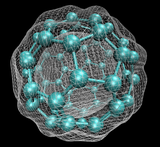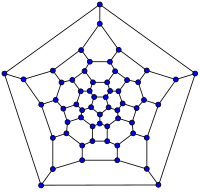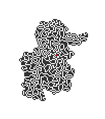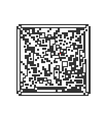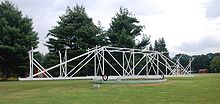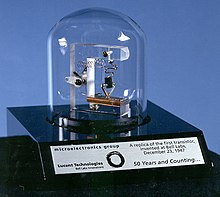
Bell Laboratories (also known as Bell Labs and formerly known as AT&T Bell Laboratories and Bell Telephone Laboratories) is the research and development organization of Alcatel-Lucent and previously of the American Telephone & Telegraph Company (AT&T).
Bell Laboratories operates its headquarters at Murray Hill, New Jersey, and has research and development facilities throughout the world.
Origin and historical locations
Early namesake

Bell's 1893
Volta Bureau building in Washington, D.C.
The Alexander Graham Bell Laboratory, also variously known as the Volta Bureau, the Bell Carriage House, the Bell Laboratory and the Volta Laboratory, was created in Washington, D.C. by Alexander Graham Bell.
In 1880, the French government awarded Bell the Volta Prize of 50,000 francs for the invention of the telephone, which he used to found the Volta Laboratory, along with Sumner Tainter and Bell's cousin Chichester Bell.[1] His research laboratory focused on the analysis, recording and transmission of sound. Bell used his considerable profits from the laboratory for further research and education to permit the "[increased] diffusion of knowledge relating to the deaf".[1]
The Volta Laboratory and the Volta Bureau were earlier located at Bell's father's house at 1527 35th Street in Washington, D.C., where its carriage house became their headquarters in 1889.[1] In 1893 Bell constructed a new building (close by at 1537 35th St.) specifically to house it.[1] The building was declared a National Historic Landmark in 1972.[2][3][4]
Early antecedent
In 1884 the American Bell Telephone Company created its Mechanical Department from the Electrical and Patent Department formed a year earlier.
Formal organization
In 1925 Western Electric Research Laboratories and part of the engineering department of the American Telephone & Telegraph company (AT&T) were consolidated to form Bell Telephone Laboratories, Inc., as a separate entity. The first president of research was Frank B. Jewett, who stayed there until 1940. The ownership of Bell Laboratories was evenly split between AT&T and the Western Electric Company. Its principal work was to design and support the equipment that Western Electric built for Bell System operating companies, including telephone exchange switches. Support work for the phone companies included the writing and maintaining of the Bell System Practices (BSP), a comprehensive series of technical manuals. Bell Labs also carried out consulting work for the Bell Telephone Companies, and U.S. government work, including Project Nike and the Apollo program. A few workers were assigned to basic research, and this attracted much attention, especially since they produced several Nobel Prize winners. Until the 1940s, the company's principal locations were in and around the Bell Labs Building in New York City, but many of these were moved to New York suburban areas of New Jersey.
Among the later Bell Laboratories locations in New Jersey were Murray Hill, Holmdel, New Jersey, Crawford Hill, New Jersey, the Deal Test Site, Freehold, New Jersey, Lincroft, Long Branch, Middletown, Princeton, Piscataway, Red Bank, and Whippany, New Jersey. Of these, Murray Hill, Crawford Hill, and Whippany remain in existence. The largest grouping of people in the company was in Illinois, at Naperville-Lisle, in the Chicago area, which had the largest concentration of employees (about 11,000) prior to 2001. There also were groups of employees in Columbus, Ohio, North Andover, Massachusetts, Allentown, Pennsylvania, Reading, Pennsylvania, and Breinigsville, Pennsylvania, Burlington, North Carolina (1950's-1970's, moved to Greensboro 1980's) and Westminster, Colorado. Since 2001, many of the former locations have been scaled down, or shut down entirely.
Discoveries and developments

Bell Laboratories logo, used from 1969 until 1983
At its peak, Bell Laboratories was the premier facility of its type, developing a wide range of revolutionary technologies, including radio astronomy, the transistor, the laser, information theory, the UNIX operating system, the C programming language and the C++ programming language. Seven Nobel Prizes have been awarded for work completed at Bell Laboratories.[5]
1920s
During its first year of operation, facsimile (fax) transmission, invented elsewhere, was first demonstrated publicly by the Bell Laboratories. In 1926, the laboratories invented the first synchronous-sound motion picture system.[6]
In 1924, Bells Labs physicist Dr. Walter A. Shewhart proposed the control chart as a method to determine when a process was in a state of statistical control. Shewart's methods were the basis for statistical process control (SPC) - the use of statistically-based tools and techniques for the management and improvement of processes. This was the origin of the modern quality movement, including the Six Sigma one.
In 1927, a long-distance television transmission of images of the Secretary of Commerce Herbert Hoover from Washington to New York was successful, and in 1928 the thermal noise in a resistor was first measured by John B. Johnson, and Harry Nyquist provided the theoretical analysis. (This is referred to as "Johnson noise".) During the 1920s, the one-time pad cipher was invented by Gilbert Vernam and Joseph Mauborgne at the laboratories. Bell Labs' Claude Shannon later proved that it is unbreakable.
1930s
In 1931, a foundation for radio astronomy was laid by Karl Jansky during his work investigating the origins of static on long-distance shortwave communications. He discovered that radio waves were being emitted from the center of the galaxy. In 1933, stereo signals were transmitted live from Philadelphia to Washington, DC. In 1937, the vocoder, the first electronic speech synthesizer was invented and demonstrated by Homer Dudley. Bell researcher Clinton Davisson shared the Nobel Prize in Physics with George Paget Thomson for the discovery of electron diffraction, which helped lay the foundation for solid-state electronics.
1940s
In the early 1940s, the photovoltaic cell was developed by Russell Ohl. In 1943, Bell developed SIGSALY, the first digital scrambled speech transmission system, used by the Allies in World War II. In 1947, the transistor, probably the most important invention developed by Bell Laboratories, was invented by John Bardeen, Walter Houser Brattain, and William Bradford Shockley (and who subsequently shared the Nobel Prize in Physics in 1956). In 1947, Richard Hamming invented Hamming codes for error detection and correction. For patent reasons, the result was not published until 1950. In 1948, "A Mathematical Theory of Communication", one of the founding works in information theory, was published by Claude Shannon in the Bell System Technical Journal. It built in part on earlier work in the field by Bell researchers Harry Nyquist and Ralph Hartley, but it greatly extended these. Bell Labs also introduced a series of increasingly complex calculators through the decade. Shannon was also the founder of modern cryptography with his 1949 paper Communication Theory of Secrecy Systems.
Calculators
- Model I - A Complex Number Calculator, completed January 1940, for doing calculations of complex numbers. See George Stibitz.
- Model II - Relay Calculator or Relay Interpolator, September 1943, for aiming anti-aircraft guns
- Model III - Ballistic Computer, June 1944, for calculations of ballistic trajectories
- Model IV - Bell Laboratories Relay Calculator, March 1945, a second Ballistic Computer
- Model V - Bell Laboratories General Purpose Relay Calculator, of which two were built, July 1946 and February 1947, which were general-purpose programmable computers using electromechanical relays
- Model VI - November 1950, an enhanced Model V
1950s
The 1950s saw fewer developments and less activity on the scientific side. Efforts concentrated more precisely on the Laboratories' prime mission of supporting the Bell System with engineering advances including N-carrier, TD Microwave radio relay, Direct Distance Dialing, E-repeaters, Wire spring relays, and improved switching systems. Maurice Karnaugh, in 1953, developed the Karnaugh map as a tool to facilitate management of Boolean algebraic expressions. In 1954, The first modern solar cell was invented at Bell Laboratories. As for the spectacular side of the business, in 1956 TAT-1, the first transatlantic telephone cable was laid between Scotland and Newfoundland, in a joint effort by AT&T, Bell Laboratories, and British and Canadian telephone companies. A year later, in 1957, MUSIC, one of the first computer programs to play electronic music, was created by Max Mathews. New greedy algorithms developed by Robert C. Prim and Joseph Kruskal, revolutionized computer network design. In 1958, the laser was first described, in a technical paper by Arthur Schawlow and Charles Hard Townes.
1960s
In 1960, Dawon Kahng and Martin Atalla invented the metal oxide semiconductor field-effect transistor (MOSFET); the MOSFET has achieved electronic hegemony and sustains the large-scale integrated circuits (LSIs) underlying today's information society. In 1962, the electret microphone was invented by Gerhard M. Sessler and James Edward Maceo West. In 1964, the Carbon dioxide laser was invented by Kumar Patel. In 1965, Penzias and Wilson discovered the Cosmic Microwave Background, and won the Nobel Prize in 1978. Frank W. Sinden, Edward E. Zajac, and Kenneth C. Knowlton made computer-animated movies during the early to mid 1960s. In 1966, Orthogonal frequency-division multiplexing (OFDM), a key technology in wireless services, was developed and patented by R. W. Chang. In 1968, Molecular beam epitaxy was developed by J.R. Arthur and A.Y. Cho; molecular beam epitaxy allows semiconductor chips and laser matrices to be manufactured one atomic layer at a time. In 1969, the UNIX operating system was created by Dennis Ritchie and Ken Thompson. The Charge-coupled device (CCD) was invented in 1969 by Willard Boyle and George E. Smith. In the 1960s, the New York City site was sold and became the Westbeth Artists Community complex.
1970s

The C programming language was developed at Bell Laboratories in 1970
The 1970s and 1980s saw more and more computer-related inventions at the Bell Laboratories as part of the personal computing revolution. In 1970 Dennis Ritchie developed the compiled C programming language as a replacement for the interpretive B for use in writing the UNIX operating system (also developed at Bell Laboratories). The original version of UNIX awk was designed and implemented by Alfred Aho, Peter Weinberger, and Brian Kernighan of Bell Laboratories.
In 1970, A. Michael Noll patented a tactile, force-feedback system, coupled with interactive stereoscopic computer display. In 1971, an improved task priority system for computerized switching systems for telephone traffic was invented by Erna Schneider Hoover, who received one of the first software patents for it. In 1976, Fiber optics systems were first tested in Georgia and in 1980, the first single-chip 32-bit microprocessor, the BELLMAC-32A was demonstrated. It went into production in 1982.
The 1970s also saw a major central office technology evolve from crossbar electromechanical relay-based technology and discrete transistor logic to Bell Labs-developed thick film hybrid and transistor-transistor logic (TTL), stored program-controlled switching systems; 1A/#4 TOLL Electronic Switching Systems (ESS) and 2A Local Central Offices produced at the Bell Labs Naperville and Western Electric Lisle, Illinois facilities. This technology evolution dramatically reduced the floor space required. The new ESS also came with its own diagnostic software that required only a switchman and several frame technicians to maintain. The technology was often touted in the Bell Labs Technical Journals and Western Electric magazine (WE People).[citation needed]
1980s

Bell Laboratories logo, used from 1984 until 1995
In 1980, the TDMA and CDMA digital cellular telephone technology was patented. In 1982, Fractional quantum Hall effect was discovered by Horst Störmer and former Bell Laboratories researchers Robert B. Laughlin and Daniel C. Tsui; they consequently won a Nobel Prize in 1998 for the discovery. In 1983, the C++ programming language was developed by Bjarne Stroustrup as an extension to the original C programming language also developed at Bell Laboratories.
In 1984, the first photoconductive antennas for picosecond electromagnetic radiation were demonstrated by Auston et al. This type of antenna now becomes an important component in terahertz time-domain spectroscopy. In 1984, the Karmarkar Linear Programming Algorithm was developed by mathematician Narendra Karmarkar. Also in 1984, a divestiture agreement signed in 1982 with the American Federal government forced the break-up of AT&T: Bellcore (now Telcordia Technologies) was split off from Bell Laboratories to provide the same R&D functions for the newly created local exchange carriers. AT&T also was limited to using the Bell trademark only in association with Bell Laboratories. Bell Telephone Laboratories, Inc., was then renamed AT&T Bell Laboratories, Inc., and became a wholly owned company of the new AT&T Technologies unit, the former Western Electric. The 5ESS Switch was developed during this transition. In 1985, laser cooling was used to slow and manipulate atoms by Steven Chu and team. Also in 1985, Bell Laboratories was awarded the National Medal of Technology "For contribution over decades to modern communication systems". During the 1980s, the Plan 9 operating system was developed as a replacement for Unix which was also developed at Bell Laboratories in 1969. Development of the Radiodrum, a three dimensional electronic instrument. In 1988, TAT-8 became the first fiber optic transatlantic cable.
1990s

Lucent Logo, bearing the "Bell Labs Innovations" tagline
In 1990, WaveLAN, the first wireless local area network (WLAN) was developed at Bell Laboratories. Wireless network technology would not become popular until the late 1990s and was first demonstrated in 1995.[dubious – discuss] Also in 1990, the AMPL modeling language was developed by Robert Fourer, David M. Gay and Brian W. Kernighan at Bell Laboratories. In 1991, the 56K modem technology was patented by Nuri Dağdeviren and his team. In 1994, the quantum cascade laser was invented by Federico Capasso, Alfred Cho, Jerome Faist, Deborah Sivco, and Al Hutchinson and was later greatly improved by the innovations of Claire Gmachl. Also in 1994, Peter Shor devised his quantum factorization algorithm. In 1996, SCALPEL electron lithography, which prints features atoms wide on microchips, was invented by Lloyd Harriott and his team. The Inferno operating system, an update of Plan 9, was created by Dennis Ritchie with others, using the new concurrent Limbo programming language. A high performance database engine (Dali) was developed which became DataBlitz in its product form.
AT&T spun off Bell Laboratories, along with most of its equipment-manufacturing business, into a new company named Lucent Technologies. AT&T retained a smaller number of researchers, who made up the staff of the newly-created AT&T Laboratories. In 1997, the smallest practical transistor (60 nanometers, 182 atoms wide) was built. In 1998, the first optical router was invented[dubious – discuss] and the first combination of voice and data traffic on an Internet Protocol (IP) network was developed at the Laboratories.[citation needed]
2000s

Logo of Alcatel-Lucent, holding the Bell Labs now
2000 was an active year for the Laboratories, in which DNA machine prototypes were developed; progressive geometry compression algorithm made widespread 3-D communication practical; the first electrically powered organic laser invented; a large-scale map of cosmic dark matter was compiled, and the F-15 (material), an organic material that makes plastic transistors possible, was invented.
In 2002, physicist Jan Hendrik Schön, was fired after his work was found to contain fraudulent data. It was the first known case of fraud at Bell Labs.
In 2003, the New Jersey Nanotechnology Laboratory was created at Murray Hill, New Jersey.[7]
In 2005, Dr. Jeong Kim, former President of Lucent's Optical Network Group, returned from academia to become the President of Bell Laboratories.
In April 2006, Bell Laboratories's parent company, Lucent Technologies, signed a merger agreement with Alcatel. On December 1, 2006, the merged company, Alcatel-Lucent, began operations. This deal raised concerns in the United States, where Bell Laboratories works on defense contracts. A separate company, LGS, with an American board was set up to manage Bell Laboratories' and Lucent's sensitive U.S. Government contracts.
In December 2007, it was announced that the former Lucent Bell Laboratories and the former Alcatel Research and Innovation would be merged into one organization under the name of Bell Laboratories. This is the first period of growth following many years during which Bell Laboratories progressively lost manpower due to layoffs and spin-offs.
As of July 2008, however, only four scientists remained in physics basic research according to a report by the scientific journal Nature.[8]
On August 28, 2008, Alcatel-Lucent announced it was pulling out of basic science, material physics, and semiconductor research, and it will instead focus on more immediately marketable areas including networking, high-speed electronics, wireless networks, nanotechnology and software.[9]
See also
References
External links





